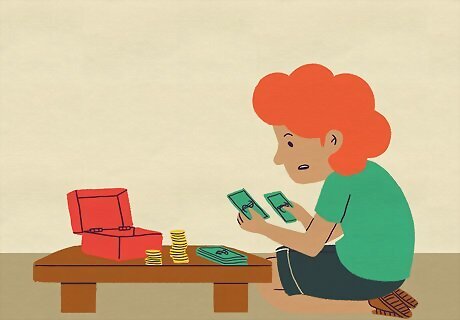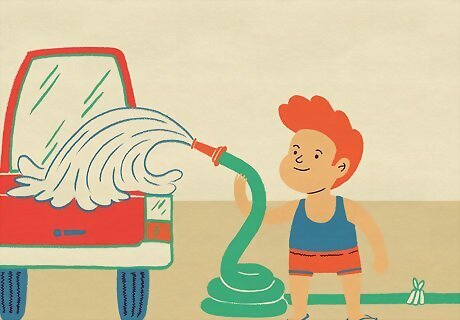
views
Babysiting

Make a babysitter’s box or bag before your first gig. Fill it with everything you might need, like a first-aid kit, snacks, and a back-up phone charger. Include things for the kids, too, like coloring books, glitter glue, toys, and puzzles. Choose items based on the ages of the kids. For example, if you're watching an infant, you'll want stuffed animals instead of toys with tiny parts that they could choke on. A basic first-aid kit should include adhesive bandages, hand sanitizer, medical tape, wet wipes, and gloves.

Figure out how much you're going to charge. The average rate for babysitting is $14 an hour. Base your own rate on your experience and the number of kids you’ll be watching. Make sure you and the parents decide on a rate before they leave you with the kids. There are babysitting apps that let parents pay you via their phone so you don't have to carry a wad of cash home. Talking about money can be awkward but don't be nervous to ask for a reasonable amount. You deserve it!

Show up 15 minutes early to go over the rules with the parents. 15 minutes is enough time to review all of the house rules, expectations, and contact information before the parents leave. Ask about bedtimes, allergies, and how they discipline their kids, too. Write it down in a notebook so you don't forget. This is a good time to discuss your payment if you haven't already. Let them know your rate now even though they'll likely pay you when they get home. Don't be late! Showing up even 1 minute late makes you look irresponsible and untrustworthy.

Stand your ground if the kids misbehave. Be firm with the kids. If they try to tell you that their parents let them do something that the parents specifically said not to do (like stay up past their bedtime), err on the side of caution and obey the parents’ rules. The parents will be impressed by your maturity and responsibility and hopefully invite you back! When in doubt, ask. Never hesitate to call the parents if you aren’t sure of something or if the kids are acting up. It’s better to be safe than sorry. Never hit or yell harshly at a child. Use an authoritative voice to remind them of the rules and the consequences if they continue to misbehave.

Take a training or certification course if you are at least 11 years old. Find one at your local community center or online on the American Red Cross’ website. Get certified in first aid and CPR, too. Not only will you learn a lot of helpful information, being certified will help you book babysitting jobs because parents will trust you more. Online courses cost $35 whereas in-person classes cost up to $89. If you’re younger than 11 or not comfortable being on your own with other kids yet, start out by being a mother’s helper. You’ll take care of the children or play with them while their mom or dad are still home.
Selling Things

Host a yard sale to get rid of things you don’t want anymore. Clean out your room and gather up all of the toys, decor, and clothes that you no longer use or want. Display your items on a folding table in your yard or driveway with your parents' permission. Put prices on each piece with a sticker label based on what you think it’s worth and the original price of the item. The best time to throw a yard sale is on the weekends in the morning. That’s when most people who shop yard sales are out and about. Ask your parents and siblings if they have anything they want to get rid of, too. If you have more variety of items at your sale, you’ll attract people of all ages. Be willing to negotiate prices. Know ahead of time what the lowest price you’ll accept for different items is and stick to it when bargaining with customers.

Sell candy if you have a lot of friends. Who doesn’t love an afternoon pick-me-up in the form of a chocolate bar? Buy candy in bulk at a warehouse store like Sam’s Club or Costco where it’s much cheaper. Then, resell the individual candy bars or packs for a profit by doubling the price. For example, if you bought 12 candy bars for $12, you paid $1 per bar. Sell them at a price of $2 and you’ll pocket $12 after deducting the original cost. If you’re planning to sell the candy at school or on the bus, check your school rules to make sure that’s allowed. Bring a parent with you if you decide to go door-to-door to stay safe.

Run a lemonade stand when it’s hot outside. You’ll need a folding table, a sign that says “Lemonade For Sale!”, plastic cups, straws, a large pitcher, ice, and, of course, lemonade. If you’re setting up your stand in the front yard, make your lemonade in the kitchen and keep it refrigerated so it stays cool. Sell the lemonade per cup. If your stand is farther from your house, make the lemonade ahead of time and store it in a cooler underneath your table. Charge extra for ice and a straw (using more materials means a higher cost!). While you can use bottled lemonade, you won’t be able to charge as much as if you make your own. People will pay more for hand-squeezed lemonade that they can’t buy themselves at the store. Selling snacks like pretzels or cookies along with the lemonade is a good way to make some extra money.

Throw a bake sale if you like to cook. Choose classic recipes that are easy to make in big batches like chewy chocolate chip cookies, fudgy brownies, or vanilla cupcakes. Once you bake everything, separate your goodies into individual servings and place them in pretty packages like treat bags tied with ribbons. Set up a stand in your front yard or out on the street corner to get more traffic. Food safety and cleanliness is very important when you’re selling homemade food. Always wash your hands with soap and water before you bake or handle food and make sure you’re using the freshest ingredients. Contact your public health department or local government to find out if you need any special permits to sell your baked goods. Although making the call may seem daunting (usually adults talk to other adults) they'll be impressed by your maturity. Use boxed mixes or make your recipes from scratch. Another option is to specialize in a certain type of food, like gluten-free or vegan baked goods, to make your bake sale unique.

Grow plants, herbs, or vegetables to sell if you have a green thumb. If your parents let you plant your own garden in the backyard, opt for easy-to-grow vegetables like lettuce, tomatoes, or cucumbers. If you will be growing your plants inside in pots, choose ones that don’t require a lot of sunlight or space. Pick your vegetables when they’re ripe and sell them in bags or plastic containers. If you’re growing flowers or herbs, consider selling the entire potted plant so the buyer can continue to enjoy it for years to come. Herbs like basil, oregano, and chives grow well indoors. Other good houseplants include succulents, ferns, and spider plants. Most vegetables should be planted in March or April to be ready to harvest in the summer. Google your specific plant or ask the local nursery if you aren’t sure.

Make money selling handmade crafts if you love being creative. Turn your hobby into a side business. Whether it’s homemade candles, friendship bracelets, or pretty cards, sell your crafts at a local craft fair, farmer’s market, or online on Etsy. Price your goods by considering how much you spent on materials and how long it took you to make each product. The more hours you spend on a piece and the more expensive the materials, the higher the price should be. You have to be at least 13 years old to start an Etsy shop and if you’re under 18, you need a parent’s permission. If you’re under 13, ask your parents to set up the shop in their name. Some boutiques and mom-and-pop stores sell local crafts. Find out if there are any in your area that will take your amazing creations.
Working Outside

Mow lawns in the summer if you can safely operate a lawn mower. Push mowers are safe for 12 year olds whereas riding mowers should only be used by teens who are at least 16 years old. Before you start mowing, ask your neighbor what height they’d like the grass, what parts of the yard you should cut, and if they have any special instructions (like not to mow too close to the flowerbed). Charge anywhere from $30 to $50 based on the size of the yard. Find out what others are charging in your area. Only mow during sunlight hours and good weather when the conditions are safest. Always wear closed-toe shoes and safety glasses to protect your eyes from flying bits of grass or debris. If your neighbor has pets or small children, ask that they be kept inside while you mow for safety reasons.

Rake yards in autumn if you live where leaves fall. Grab a rake and a few large trash bags and go from house to house offering your services. Ask your neighbors what areas of their lawn they want raked and where you should put the leaves, like on the curb for collection or dumped in a wooded area behind their house. Rake leaves into a large pile, then stuff them into a trash bag and tie it closed. Avoid raking leaves immediately after it rains. Wet leaves are much heavier and difficult to rake up. Wait for the yard to dry out before raking it. If you’re dumping the leaves instead of bagging them, use a large rubber trash can with wheels instead of a trash bag. It’s easy to fill and roll to wherever you’re putting the leaves.

Shovel driveways and sidewalks in the winter if it snows in your area. Pick a shovel that’s lightweight yet sturdy and has a non-stick blade. Come up with a shoveling strategy, whether it’s working from the top of the driveway to the bottom or going in diagonal lines across the driveway. Push the snow from side to side and only pick it up when you need to avoid wearing yourself out fast. Charge a flat rate of $10 to $20 depending on the size of the driveway and whether your neighbors want you to shovel their sidewalks or front porch. When you’re shoveling snow, always bend at your knees, not at your waist, to protect your back. Dress appropriately for the cold weather since you’ll be outside for hours. Wear a heavy coat, waterproof gloves, a hat or earmuffs, and snow boots with a good tread so you don’t slip on ice.

Take care of your neighbors’ gardens in the spring if they have them. Volunteer to weed the garden, plant flowers, water the plants, or mulch the garden. People begin tending to their gardens as early as March so start advertising your services at the end of February or the beginning of March. It’s a great way to get outside and learn how to garden. For weeding, planting, or mulching, charge by the hour. For example, if your rate is $5 an hour and you spend 3 hours on Sunday morning mulching the garden, you’ll get $15. Since watering plants isn’t an hourly job, charge a flat rate based on how many plants there are and how often you’ll be required to water them.

Wash cars or bikes if you have a big enough driveway. Gather some sponges or old rags, towels, car washing liquid, a big bucket, and a hose and set up a washing station in your driveway for a few hours on the weekend. Scrub each vehicle, focusing on any dirty spots, rinse it thoroughly, and buff it dry with a microfiber towel. Charge $10 to $20 per vehicle. Advertise your services the week before so your neighbors know you’re open for business. Make a little extra money by offering to clean the inside of the car, too, which is known as detailing. Vacuum the floor mats, wipe down the dashboard, and clean out the cupholders. If you get really busy, “hire” some friends to help out. Just remember that means you’ll have to split the money, too.
Finding Odd Jobs

Do household chores if you like cleaning. If your parents already pay you an allowance, find out if you can make a little extra money by going above and beyond. Offer to do the laundry, clean the bathrooms, or vacuum all the rugs in the house. Let your neighbors know that you’re available for hire, too. Elderly neighbors in particular who have difficulty doing things around the house will appreciate your services. Don’t expect to get paid for doing the tasks you’re already expected to do like keeping your own room tidy or cleaning up after yourself in the kitchen.

House sit if you have neighbors who go on vacation. Water their plants, take out the trash, check the mail, and keep an eye on things. They may ask you to visit 1 to 2 times a day or even spend the night at their house so it doesn’t look empty and prevents burglary. Follow all of your neighbor’s rules and instructions and always lock up the house when you leave to keep it safe. If you have to stay the night, ask an older sibling or parent to stay with you. Ask your neighbor to write down all of the important instructions in case you forget, along with their contact information so you can reach them if there’s an emergency or if you have a question. Be respectful of your neighbor’s home. They’re trusting you with a huge responsibility so don’t break that trust by inviting friends over, eating their food, or using their things, unless they tell you it’s okay to do so.

Walk dogs if you’re comfortable with animals. Ask your neighbors with dogs if they need a walker. Show up on time each day and bring an extra leash, water bottle, dog bowl, and poop bags just in case. Walk the dog for the amount of time your neighbor specifies and charge a rate based on the length of the walk and how much experience you have. Write down your schedule on your phone or in a planner to keep track of which dogs you’re walking on which days. Spending time with the dog before your first walk will help both you and the dog get to know each other. Ask your neighbor if you can play with them in the backyard for an hour or so before your first day. Know your limits. You might not be comfortable with dogs who are overly aggressive. Say no to opportunities if you feel unsure of yourself, even if it’s good pay.

Feed and take care of your neighbors’ pets while they’re out of town. Pet sitting is just like babysitting but for animals. If you’re comfortable with animals, let your neighbors know that you’re available to watch their pets when they go away. Always respect their rules and ask ahead of time if you have any questions about the care instructions. Meet with your neighbor before they leave to go over exactly what you need to do as well as determine how much they’re going to pay you. How much you charge will depend on the length of your pet sitting, how many animals you’re watching, and how much responsibility you have. For example, if you’re just feeding their fish once a day, you’ll charge less than if you’re walking their dog 2 times a day and giving him insulin shots. Write down all of the necessary contact information in case of an emergency, like your neighbors' cell phone numbers, the vet’s name and phone number, etc.

Tutor kids in a subject that you’re an expert at if you like teaching. Think about the classes you do best in at school or the topics you know a lot about. Help out your peers or teach younger kids who want to get a head start before the next school year. Put up fliers around your neighborhood or school with the topics you’re tutoring, the cost, and what services you offer. Charge either an hourly rate or a flat rate per session. Make sure your price is fair for how much help you’re offering. For example, if you’re just helping someone study their algebra flashcards, you’d charge less than if you’re coaching someone through an English paper. Prepare for a tutoring session by reviewing the material, purchasing textbooks or practice books, and asking your student what sorts of things they’re learning in class or what they’re having trouble with.

Paint friends’ nails for a small fee if you have a steady hand. All you need are a few pretty polishes and a little creativity to start your own pop-up nail studio. Charge extra for fancy designs, glitter, or stick-on jewels. Offer a discount if they get a manicure and a pedicure. For example, if a manicure is $5 and a pedicure is $6, make a mani-pedi $10 for a $1 savings to encourage people to spend more. Watch video tutorials online to learn how to draw designs like flowers, swirls, or stars. Trim nails, give hand massages with cuticle cream, or remove old polish for an additional cost.

Deliver newspapers every morning if there's a route in your community. Find out if there are routes available in your area by contacting your local newspaper. Collect your bag of papers each morning and ride your bike from house to house to hand them out or have your parents drive you around. Most newspapers have to be delivered very early around 5 a.m. so be prepared to wake up at the crack of dawn. The average wage for delivering newspapers is $11.48, according to the Bureau of Labor Statistics. If you don’t want to work every single day, share your route with 2 to 3 friends or family members and switch off days. Some of the world’s most successful men, like Walt Disney, Warren Buffett, and Tom Cruise, started out delivering newspapers.

Recycle items at the local recycling center if they accept collections. Many recycling sites will pay a small fee per pound of recyclable items. Go around your neighborhood collecting things like glass bottles, soda cans, newspapers, cereal boxes, and milk jugs. Have your parents drive you to the nearest recycling center and turn in your haul in exchange for money. Some recycling centers require you to prepare items before you recycle them like rinsing cans or taking caps off bottles. Call your collection site to find out what their regulations are. To know if a piece of plastic can be recycled, look for the recycling symbol (a triangle made of 3 arrows) on the bottom or back of the container. If the number inside the triangle is 1 or 2, it can be recycled. If the number is 3, 6, or 7, it cannot be recycled. And if the number is 4 or 5, check with your recycling center.















Comments
0 comment